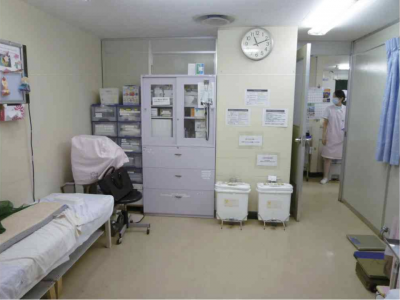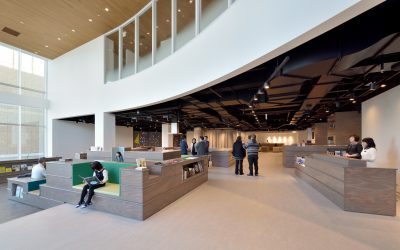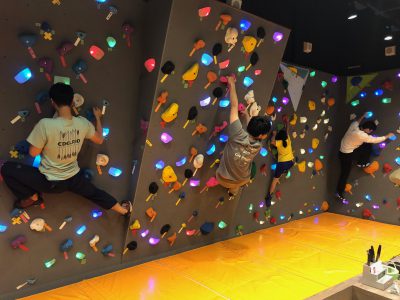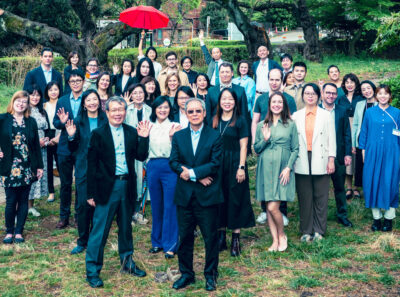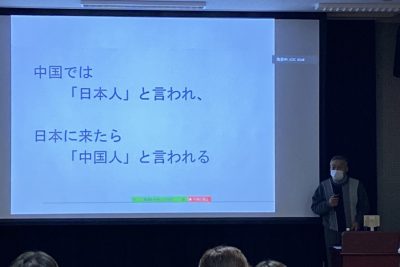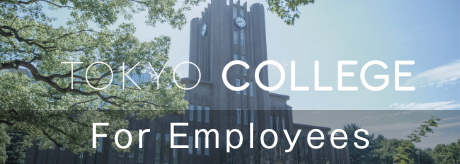Toward 2050: Hospitals of the Future – The Role of Art
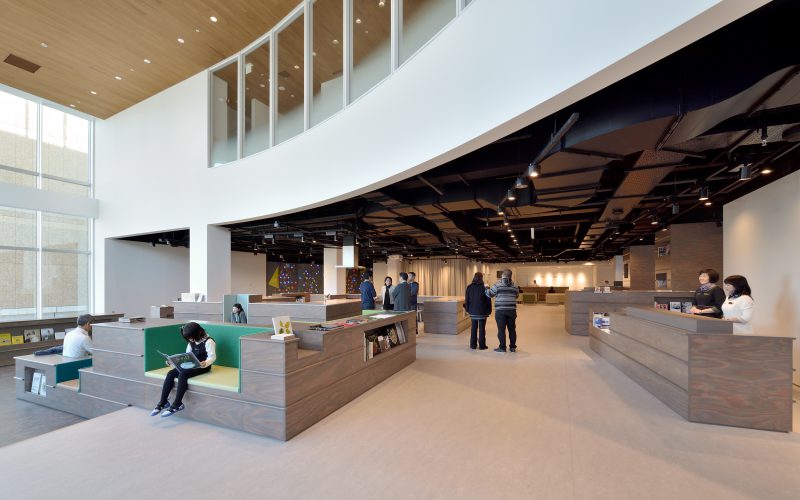
This blog post was created as part of the seminar "The Earth and Human Society in 2050: Interdisciplinary Perspectives " offered by members of Tokyo College in autumn 2020. In this course, undergraduate students from different fields of specialization chose one pressing challenge confronting human society, developed an interdisciplinary understanding of that issue through collaborative learning, and shared their results in class. This article presents a research outcome on the role of art in hospitals carried out by one of the participants.
Author
KOBATAKE Miho
BA Student, Natural Sciences II, College of Arts and Sciences Junior Division, The University of Tokyo
The streamlining of medical treatment has advanced with the spread of the coronavirus pandemic. Now in the midst of fear of over-run hospitals, implementing more efficient medical care will lead to more people being saved. However, to truly save patients efficiently, it is necessary to do some things which, at first sight, are not efficient. This is because giving too much attention to curing diseases can cause the patient’s condition to deteriorate. Hospitals are involved in many people’s lives. I would like to examine here the notion that by using the power of art, hospitals can not only cure diseases, but can also become places that care about patients.
Firstly, what image do you have of hospitals? For me, a hospital is a place where I get a little nervous and where illnesses are cured. I’d like to tell you about an episode I heard from a doctor who conducts home visits. The patient the doctor was seeing had been hospitalized for a long time, but when he found out he was approaching the end of his life, he said he wanted to go home. He was able to return home with the cooperation of the people concerned, and was given end-of-life care at home, as he had wished. When the doctor informed the hospital that the patient had passed away, one of the nurses said, “It was nice that he was able to return home.” The doctor was shocked by the nurse’s perception that end-of-life care at the hospital was not good. In fact, patients tend to have a similar perception. Roughly 60% of people feel they “want to take their final recuperation at home” or “want to recuperate at home and use medical institutions if necessary” (Ministry of Health, Labour and Welfare, 2017). This made me feel that hospitals are places where illnesses are cured, but not places where people are healed.
However, hospitals should not only be places for curing illnesses, but also places for spending one’s life and for ending one’s life. This is because many people spend a part of their lives or even the final stages of their lives in hospitals. For example, patients who are receiving dialysis treatment visit the hospital frequently. It is standard for such patients to visit the hospital three times a week for a four-hour dialysis session each time, and this treatment often continues for the person’s whole lifetime. The last stage of life is also generally spent in a hospital. In fact, 81% of end-of-life care is given in hospitals (Ministry of Health, Labour and Welfare, 2017). As mentioned above, in spite of hospitals being places where some or a large part of one’s life is spent, and where one’s life ends, today’s hospitals are felt to be unsuitable for this. In other words, hospitals should not only be places for curing illnesses but also need to be places that support life.
Here, I propose that hospitals be designed not only for “curing illnesses” but also with an emphasis on “caring for the patient.” This is the opposite of conventional streamlining improvements, and is a move to increase ease and comfort. Art is very suitable for invoking this sense of comfort, and creates feelings of richness and abundance in patients’ minds. Here, I define art as the creation and appreciation of creativity. This can also be said as expressions that appeal to people’s sensibilities. Examples include painting, music, writing, design, and architecture. The hospitals we have known up to now have emphasized efficiency and cleanliness, and art has not generally played any kind of role. As a concrete example, let’s consider color. When you think of hospitals in general, you probably associate them with clean, sanitary white walls, and tidy wards and corridors. White is efficient in medical treatment because dirt is easily visible, making it easy to maintain cleanliness and hygiene. In the 19th century, according to Kurihara (2014), surgeons dressed in black when performing operations. This was because, as with suits, black was thought to be a formal color, and therefore suitable for surgery. From the late 19th century, white came to be chosen for hygiene efficiency in Europe and the United States. Today, however, hygiene management is possible with any color. As white gives an impression of being inorganic and cold, especially in pediatrics and psychiatry, white is no longer used in order to avoid tension. Instead, warm hues are increasingly used for walls, wards, and playrooms. The architect Kiyofumi Okamoto (Professor, Faculty of Literature, Arts and Cultural Studies, Kindai University) has redesigned pediatric treatment rooms of the University Hospital to balance the alleviation of patient fears with ease of medical treatment (2013).
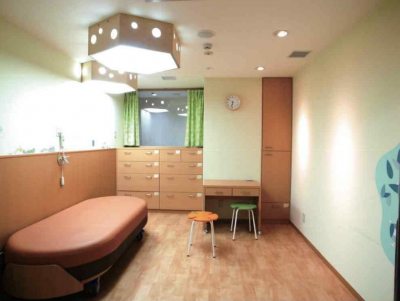
(Above) Pre-renovation, (Below) Post-renovation (Source: Okamoto 2013: pp 117, 127)
You can see from the photos that everything from the color tones of the room to the positioning of the lights, the wall designs, and the flooring materials have been very skillfully designed. In this way, the viewpoint of care is added to hospital design through the intervention of artists.
I would now like to introduce some recent hospital styles that have incorporated art into their designs.
Kagayaki Lodge
Established in 2017, Kagayaki Lodge is a home medical care clinic in Hashima County, Gifu Prefecture. The building design makes use of wood to give a warm feeling, and the large windows that look out onto the garden create a sense of openness. As the building was constructed using wood, it can reportedly last for 200 years if it is repaired a little at a time. The clinic has been built to enclose more than three times the space required for the work, and includes space that is used for apparently non-medical purposes such as a cafeteria, study rooms and an exhibition hall. These were created as spaces where not only patients but also their families, friends and community members could gather. This is what makes it possible to anticipate recovery from “poor health,” resulting from loneliness, moodiness and lack of self-affirmation.
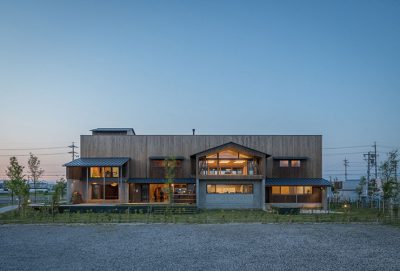
Photo: ToLoLo studio Source: Kentaro Ataka Architectural Design / PATLUCK Inc. Website: http://www.ataken.com/kagayaki-L/kagayaki-L.html
Vision Park
Vision Park is a comprehensive support area for people with visual disabilities located in the entrance area of Kobe Eye Center, an ophthalmic general hospital established in Kobe City, Hyogo Prefecture in 2017. The space is, in fact, designed with several different levels, and there are no handrails. At first glance, it would seem that there has been no consideration for those with visual disabilities. The designer, however, having listened to the opinions of the people involved, devised the height of steps so that they could be tackled safely with a white cane, and arranged the furniture so that it could be used as handrails. The design is not intended to eliminate various kinds of dangers, but to draw out the vital power of people with visual disabilities. This entrance, with its several levels and lack of handrails also has climbing walls and kitchen facilities. The bouldering trainers are also living with visual disabilities. It is possible to say that this is a place where people with disabilities are not forced into the category of people who are supported by society, but where they are respected as individuals and encouraged to interact with others and their surroundings.
In fact, the perspective of care incorporating this kind of art has a wide range of positive effects on patients. According to one study, when patients’ rooms were decorated with visual art for two weeks, it was discovered that, through art, patients may potentially feel more socially connected and safe, and that addressing their own memories may make it possible for them to distract themselves from their illness (Nielsen, et al., 2016). The study measured the effects on patients from four perspectives: physical, social, emotional, and cognitive. As this assessment method shows, the use of art can encourage holistic care of the comprehensive condition of patients, not simply their illnesses. This is how the spirit of caring comes to have positive impacts on patients.
The challenge for 2050, about 30 years from now, will be the enormous cost of running hospitals. Art as comforting ambience is necessary to create and operate hospitals that really care for patients. One may argue that this comforting ambience is “wasteful” and is the exact opposite of efficient medical care. The Kagayaki Lodge and Vision Park introduced above are designed to be spacious, and this space is extremely costly in terms of land, staff and maintenance costs. In fact, the website of NEXT VISION, the public interest incorporated association that operates Vision Park, states, “We require support of a few hundred thousand yen a year to continue our support activities and systems.” Incorporating art seems, at first sight, expensive, inefficient, and nothing but “wasteful.” But paradoxically, efficient medical care can be achieved by going in the opposite direction from streamlining. This is because we can truly save the “patient” by not only curing the disease, but also by holistically considering the overall condition of the patient. Having this all-embracing perspective in mind, it may be possible to feel that the cost is not so high after all.
As described above, by introducing art and moving away from medical care that aims only at streamlined efficiency, hospitals can focus on “care” for the patient, not only the “cure” for illnesses. It is likely that art will come to play an even greater role in the hospitals of the future in a way that complements medical perspectives.
References
Ataka Kentaro, Kentaro Ataka Architectural Design, PATLUCK inc., Kagayaki Lodge (安宅研太郎/アタカケンタロウ建築計画事務所/株式会社パトラック (n.d.) “かがやきロッジ”), (Online), Available at: www.ataken.com/kagayaki-L/kagayaki-L.html (Accessed 13 March 2021)
Okamoto Kiyofumi, 2013, Art Gallary HART Project - Space Design of the Treatment Room for the Pediatrics Department, Bulletin of the School of Literature, Arts and Cultural Studies, Kinki University, Vol.24 No.2 (岡本清文 (2013) “アートギャラリー HARTプロジェクト−小児処置室の空間デザイン”, 文学・芸術・文化 : 近畿大学文芸学部論集, 第24巻第2号) (Online), Available at: kindai.repo.nii.ac.jp/?action=pages_view_main&active_action=repository_view_main_item_detail&item_id=7962&item_no=1&page_id=13&block_id=21 (Accessed 13 March 2021)
Kurihara Hiroshi, 2014, Research on the Personal Appearance of Doctors: Comparison and Analysis of the Viewpoints of Patients and Medical Students (栗原宏 (2014) “医師の身だしなみに関する研究:患者視点と医学生視点の比較・検討”), (Online), Available at: core.ac.uk/download/pdf/56660545.pdf (Accessed 17 March 2021)
Ministry of Health, Labour and Welfare, 2017, Theme 1: End-of-Life Care, Reference Material (厚生労働省 (2017)), (Online), Available at: www.mhlw.go.jp/file/05-Shingikai-12404000-Hokenkyoku-Iryouka/0000156003.pdf (Accessed 3 March 2021)
Kobe City, 2019, Kobe Eye Center Vision Park Wins One of the World’s Three Greatest Design Awards, the International Design Excellence Awards (IDEA) 2019 (神戸市 (2019) “神戸アイセンター ビジョンパークが世界3大デザイン賞のひとつ「International Design Excellence Awards (IDEA) 2019」を受賞”), (Online), Available at: www.city.kobe.lg.jp/a57337/shise/press/press_back/2019/press_201908/20190827041701.html (Accessed 13 March 2021)
Kobe Citizen’s Well-being Promotion Association, 2019, Kobe Eye Center, Vision Park (こうべ市民福祉振興協会 (2019) “神戸アイセンター Vision Park”), (Online), Available at: www.shiawasenomura.org/ud_casestudy/r1/4959 (Accessed 13 March 2021)
Nielsen S. L., Fich L. B., Roessler K. K., & Mullins M. F. (2017) “How do patients actually experience and use art in hospitals? The significance of interaction: a user-oriented experimental case study”, International Journal of Qualitative Studies on Health and Well-being, 12(1), (Online) DOI: 10.1080/17482631.2016.1267343
Japan Institute of Design Promotion, 2018, Hospital [Vision Park] (日本デザイン振興会 (2018) “病院 [ビジョンパーク]”), Good Design Gold Award 2018, (Online), Available at: www.g-mark.org/award/describe/48053 (Accessed 13 March 2021)
Japan Institute of Design Promotion, 2019, Clinic [Kagayaki Lodge] (日本デザイン振興会 (2019) “クリニック [かがやきロッジ]”), Good Design Gold Award 2019, (Online), Available at: www.g-mark.org/award/describe/49721
NEXT VISION (ネクストビジョン) (n.d.) (Online), Available at: nextvision.or.jp (Accessed 13 March 2021)
Yamazaki Kentaro Design Workshop, Vision Park (山﨑健太郎デザインワークショップ (n.d.) “ビジョンパーク”), (Online), Available at: ykdw.org/works/ビジョンパーク/ (Accessed 13 March 2021)


